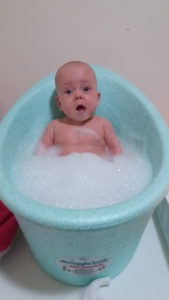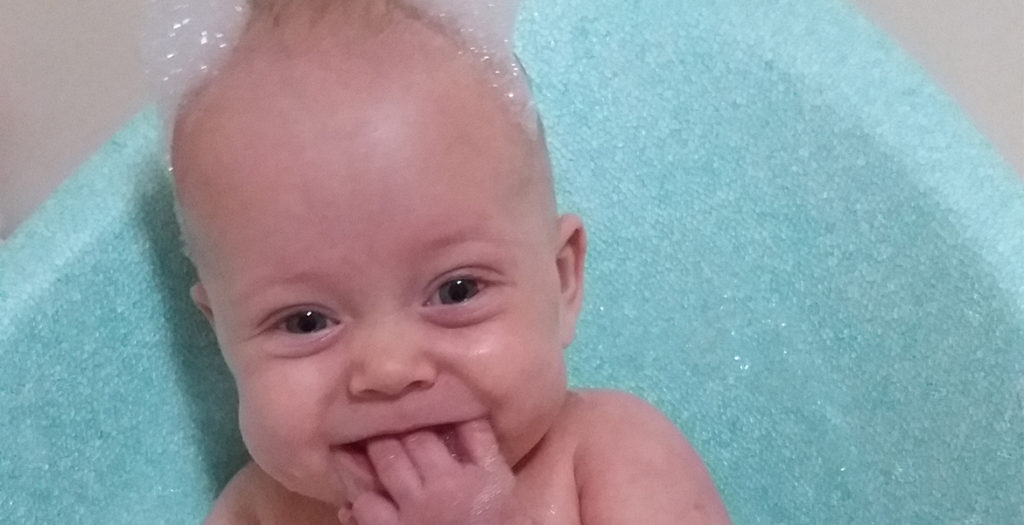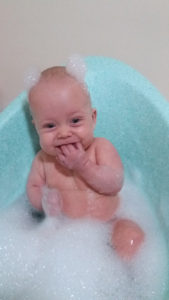We show you how and when to start giving your baby their first bath in our tots’ tub time feature
All babies need bating – right? Well, not always. We show yo when to bath and when not to.
When to start
 Your baby does not need bathing as soon as he is born.
Your baby does not need bathing as soon as he is born.
Although this might have been a common practice in years gone by, today we realise that your tot arrives with a special coating from inside the womb called vernix that protects the skin and prevents it from drying out. So apart from a little rub with a warm, soft, towel to clean off any blood, midwives will usually just wrap your baby and hand him straight to you.
Top and tail
Until the umbilical cord dries up and falls off, you can just top and tail your baby rather than giving him a full bath, which means cleaning his head and bottom with just warm water and cotton wool. Take two clean bowls, fill them with water that is elbow-warm and then, using a clean piece of cotton wool each time, clean each eye from the inner corner outwards, then around the mouth and nose, then around the face, making sure you don’t miss any creases in the neck where dribble and milk can collect.
Then wash their hands and feet. Next, with the second bowl, clean around the nappy area, working from front to back to avoid bacteria from the bottom getting into the urethra (especially with girls) and then pop their nappy back on. A warm towel can cover the part you’re not working, on so your baby doesn’t get too cold.
See six of the best baby bath tubs
 What to use
What to use
For newborns, don’t use soap, baby shampoo or bath lotion. Plain water is fine. As you switch to bathing properly, you can use a very mild bath wash and shampoo (many do both jobs), making sure you choose one that is suitable for babies. Cuddle baby dry, then apply a baby-friendly body lotion or oil.
Beginning to bathe
Once you decide to start bathing your baby properly – and it’s fine to wait until you feel you’re up to it – you can start to work a bath into your baby’s bedtime routine. You may discover it’s worth waiting for a few weeks, as not only will you feel more competent to hold a wriggly, wet baby but you won’t be so tired.
Also, you’ll have started to work out your baby’s routine – though play it by ear for now, as there are no definites at this age. Bath time can wear your baby out – all that excitement, playtime and bubbles can be very tiring, so it can help him get to sleep and stay asleep for a little longer than he may have done previously.
How to bathe
Make sure you have all you need before you start; towels, clean clothes and nappies, then fill whatever bath you are using, or the basin and check the temperature with your elbow – not your hand, which can take higher temperatures. Undress your baby except for his nappy (keep him wrapped in a warm towel for now), top and tail him, then remove the nappy and in you go!
Make sure you keep a firm grip with one hand and wash with the other. Bear in mind that baby boys tend to pee as soon as their nappy comes off – often with fountain-like strength! So keep the old nappy over the area which changing.
Skin
Babies can get dry skin or eczema, psoriasis and other skin problems, especially during the first year. Make sure you check it out with a doctor or health visitor and look for a product to help you treat it. The best advice is to look for something as natural as possible, as harsh chemicals and additives can irritate further.
If he has dry, red and even cracked skin it’s likely to be eczema. Try to avoid creams with steroids, as although many doctors prescribe these for serious cases, they can thin the skin. Soak your baby in a cool bath of plain water for as long as you can to get that moisture into the skin, then seal it in after his bath with a gentle and natural cream.
Safety first
When you are bathing your baby, you must never leave him unattended, even for a second. A baby can drown in just a few centimetres of water and a fall from a high changing unit or bath on a stand could cause serious injuries.
Make sure you have all you need before you start and keep one hand holding your baby while the other washes. The best way to hold your baby is to have your hand beneath their head and shoulders, holding onto the arm opposite you.
See our feature on six of the best baby baths.


 What to use
What to use